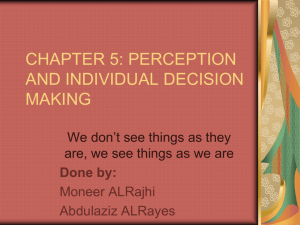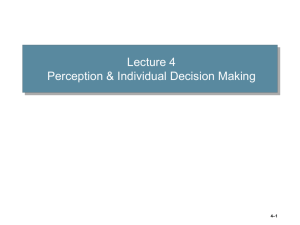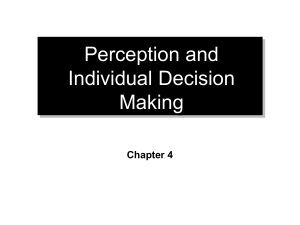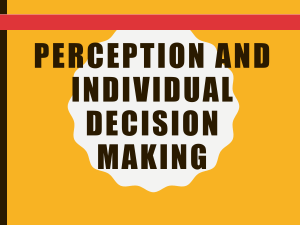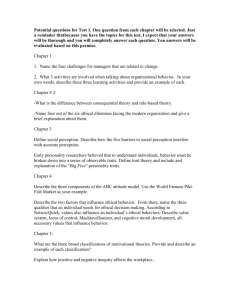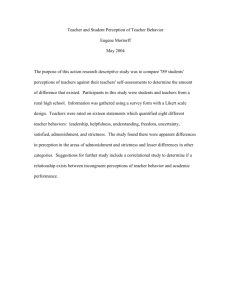Organizational Behavior 10e
advertisement
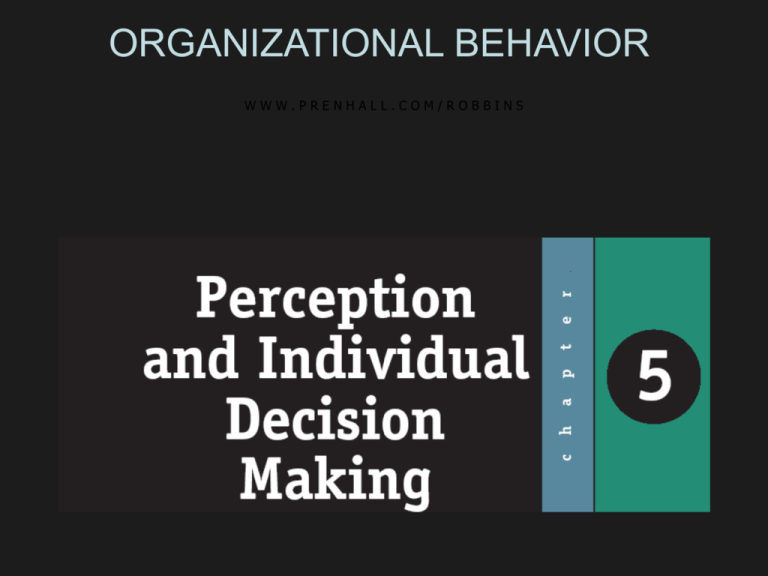
ORGANIZATIONAL BEHAVIOR WWW.PRENHALL.COM/ROBBINS OBJECTIVES LEARNING After studying chapter five and listening to my lecture,you should be able to: 1. Explain how two people can see the same thing and interpret it differently. 2. List three determinants of attribution. 3. Describe how shortcuts can assist in or distort our judgment of others. 4. Explain how perception affects the decisionmaking process. 5. Outline the six steps in the rational decisionmaking model. O B J E C T I V E S (cont’d) LEARNING Outline continues: 6. Describe the action of a boundedly rational decision maker. 7. Identify the conditions in which individuals are most likely to use intuition in decision making. 8. Describe four styles of decision making. 9. Define heuristics and explain how they bias decisions. 10. Contrast the three ethical decision criteria. What Is Perception, and Why Is It Important? • People’s behavior is based on their perception of what reality is, not on reality itself. • The world as it is perceived is the world that is behaviorally important. Factors That Influence Perception EXHIBIT 5-1 Person Perception: Making Judgments About Others Distinctiveness: shows different behaviors in different situations. Consensus: response is the same as others to same situation. Consistency: responds in the same way over time. Attribution Theory EXHIBIT 5-2 Errors and Biases in Attributions Errors and Biases in Attributions (cont’d) Frequently Used Shortcuts in Judging Others Frequently Used Shortcuts in Judging Others Frequently Used Shortcuts in Judging Others Specific Applications in Organizations Employment Interview – Perceptual biases affect the accuracy of interviewers’ judgments of applicants. Performance Expectations – Self-fulfilling prophecy (pygmalion effect): The lower or higher performance of employees reflects preconceived leader expectations about employee capabilities. Performance Evaluations – Appraisals are subjective perceptions of performance. Employee Effort – Assessment of individual effort is a subjective judgment subject to perceptual distortion and bias. The Link Between Perceptions and Individual Decision Making Perceptions of the decision maker Outcomes Assumptions of the Rational Decision-Making Model 1. Problem clarity 2. Known options 3. Clear preferences 4. Constant preferences 5. No time or cost constraints 6. Maximum payoff Steps in the Rational Decision-Making Model EXHIBIT 5-3 The Three Components of Creativity EXHIBIT 5-4 How Are Decisions Actually Made in Organizations How Are Decisions Actually Made in Organizations (cont’d) How/Why problems are identified – Visibility over importance of problem • Attention-catching, high profile problems • Desire to “solve problems” – Self-interest (if problem concerns decision maker) Alternative Development – Satisficing: seeking the first alternative that solves problem. – Engaging in incremental rather than unique problem solving through successive limited comparison of alternatives to the current alternative in effect. Making Choices Making Choices Decision-Style Model EXHIBIT 5-5 Organizational Constraints on Decision Makers Performance Evaluation – Evaluation criteria influence the choice of actions. Reward Systems – Decision makers make action choices that are favored by the organization. Formal Regulations – Organizational rules and policies limit the alternative choices of decision makers. System-imposed Time Constraints – Organizations require decisions by specific deadlines. Historical Precedents – Past decisions influence current decisions. Cultural Differences in Decision Making Problems selected Time orientation Importance of logic and rationality Belief in the ability of people to solve problems Preference for collect decision making Ethics in Decision Making Ethical Decision Criteria – Utilitarianism • Seeking the greatest good for the greatest number. – Rights • Respecting and protecting basic rights of individuals. – Justice • Imposing and enforcing rules fairly and impartially. Ethics in Decision Making Ethics and National Culture – There are no global ethical standards. – The ethical principles of global organizations that reflect and respect local cultural norms are necessary for high standards and consistent practices.
